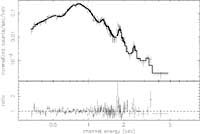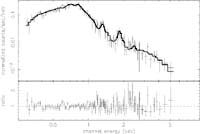


The total X-ray luminosity emitted from M83 in the 0.3-8.0 keV band is
 2.5 ×
1040 erg s-1
(1).
Of this,
2.5 ×
1040 erg s-1
(1).
Of this,  6 ×
1039 erg s-1 comes
from the resolved sources and the rest is unresolved.
The nuclear starburst contributes for
6 ×
1039 erg s-1 comes
from the resolved sources and the rest is unresolved.
The nuclear starburst contributes for
 5 ×
1039 erg s-1 (of which
5 ×
1039 erg s-1 (of which
 1 ×
1039 erg s-1 from resolved sources).
The unresolved X-ray emission is dominated
by a multitemperature, optically thin plasma component, at
kT ~ 0.2-0.7 keV,
slightly hotter in the nuclear region than in the arms
(Figures 1, 2).
It is likely to originate from gas shock-heated by core-collapse SN
explosions (2).
The unresolved emission from the disk region
has a power-law-like tail that dominates above 3 keV.
Its origin is still unclear: a population of faint,
unresolved XRBs can produce a power-law component.
The emission can also be due to a second thermal plasma
component at kT > 2 keV, or to Compton upscattering of far-IR
photons by relativistic electrons
(Valinia & Marshall
1998).
1 ×
1039 erg s-1 from resolved sources).
The unresolved X-ray emission is dominated
by a multitemperature, optically thin plasma component, at
kT ~ 0.2-0.7 keV,
slightly hotter in the nuclear region than in the arms
(Figures 1, 2).
It is likely to originate from gas shock-heated by core-collapse SN
explosions (2).
The unresolved emission from the disk region
has a power-law-like tail that dominates above 3 keV.
Its origin is still unclear: a population of faint,
unresolved XRBs can produce a power-law component.
The emission can also be due to a second thermal plasma
component at kT > 2 keV, or to Compton upscattering of far-IR
photons by relativistic electrons
(Valinia & Marshall
1998).
From the observed temperature and luminosity,
we estimate an average density ne
 5 ×
10-2 cm-3 and a total mass ~ 107
M
5 ×
10-2 cm-3 and a total mass ~ 107
M for
the X-ray emitting gas in M83; the cooling timescale is
for
the X-ray emitting gas in M83; the cooling timescale is
 108
yr. For the hot gas in the starburst nuclear region,
ne
108
yr. For the hot gas in the starburst nuclear region,
ne  0.2 cm-3,
M
0.2 cm-3,
M  5 ×
105
M
5 ×
105
M ,
tc
,
tc  4 × 107 yr.
Hence, the hot gas is an indicator of recent star formation.
4 × 107 yr.
Hence, the hot gas is an indicator of recent star formation.
 |
 |
Figure 2. Left: the
Chandra/ACIS spectrum
of the unresolved emission in the starburst nucleus of M83 shows
a thermal plasma component
(kT |
|
1 In other bands:
LB  2.5 × 1043 erg s-1, LFIR
2.5 × 1043 erg s-1, LFIR
 2.5 ×
1043 erg s-1,
LH
2.5 ×
1043 erg s-1,
LH
 1.5 ×
1040 erg s-1. In general, LX ~
LH
1.5 ×
1040 erg s-1. In general, LX ~
LH ~
10-3LFIR
for starburst spirals
(Fabbiano & Shapley
2002;
Calzetti et al. 1995;
Condon et al. 1998;
de Vaucouleurs et al. 1991);
all three bands can be used as indicators of star formation.
Back.
~
10-3LFIR
for starburst spirals
(Fabbiano & Shapley
2002;
Calzetti et al. 1995;
Condon et al. 1998;
de Vaucouleurs et al. 1991);
all three bands can be used as indicators of star formation.
Back.
2 SN ejecta can easily provide
vsh ~ T1/2 > 650 km s-1,
required to heat the gas to kT
 0.5 keV.
Assuming a SN rate ~ 0.05 yr-1 for M83, and a total mechanical energy
0.5 keV.
Assuming a SN rate ~ 0.05 yr-1 for M83, and a total mechanical energy
 1051 erg
injected into the ISM by each SN, the total mechanical luminosity is
1051 erg
injected into the ISM by each SN, the total mechanical luminosity is
 1.5 ×
1042 erg s-1.
Back.
1.5 ×
1042 erg s-1.
Back.